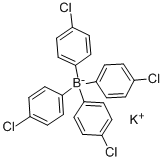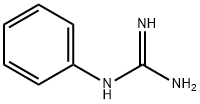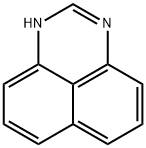2-Aminoperimidine Hydrobromide
- CAS NO.:40835-96-9
- Empirical Formula: C11H10BrN3
- Molecular Weight: 264.12
- MDL number: MFCD00012749
- EINECS: 255-101-4
- SAFETY DATA SHEET (SDS)
- Update Date: 2024-03-04 11:02:28

What is 2-Aminoperimidine Hydrobromide?
What are the applications of Application
Formation of an ion associated with the excess of 2-aminoperimidine hydrobromide (Ap) and sulfate ion in the sample solution and detection of the concentration of the remaining Ap ion by the optode. The developed optode method could be applied to determine sulfate ions in environmental water samples[1].
Purification Methods
Purify the hydrobromide by boiling a saturated aqueous solution with charcoal, filtering and leaving the salt to crystallise. Store this dihydrate salt in a cool, stoppered flask in the dark place. The anhydrous salt is obtained by heating at 80o/4hours, and it is hygroscopic. The solubilities of the hydrobromide at 26o are 2.4% in EtOH, 0.6% in H2O, 0.3% in Et2O, 0.1% in Me2CO and 0.003% in *C6H6. [Dasgupta et al. Anal Chim Acta 94 205 1977, Dasgupta & West Microchim Acta 2 505 1978, Dasgupta et al. Anal Chem 50 1793 1978, Beilstein 24 H 193, 25 III/IV 2677.]
References
[1] Takashi Masadome, Hidekazu Ishikawa. “Determination of Sulfate Ion with 2-Aminoperimidine Hydrobromide Using an Optode Based on Tetrabromophenolphthalein Ethyl Ester Membrane.” Analytical Sciences 34 3 (2018): 383–385.
Properties of 2-Aminoperimidine Hydrobromide
| Melting point: | 295-300 °C |
| solubility | soluble in Methanol |
| form | powder to crystal |
| color | White to Light yellow to Dark green |
| BRN | 3570810 |
| InChI | InChI=1S/C11H9N3.BrH/c12-11-13-8-5-1-3-7-4-2-6-9(14-11)10(7)8;/h1-6H,(H3,12,13,14);1H |
| CAS DataBase Reference | 40835-96-9(CAS DataBase Reference) |
Safety information for 2-Aminoperimidine Hydrobromide
| Signal word | Warning |
| Pictogram(s) |
 Exclamation Mark Irritant GHS07 |
| GHS Hazard Statements |
H315:Skin corrosion/irritation H319:Serious eye damage/eye irritation H335:Specific target organ toxicity, single exposure;Respiratory tract irritation |
| Precautionary Statement Codes |
P261:Avoid breathing dust/fume/gas/mist/vapours/spray. P305+P351+P338:IF IN EYES: Rinse cautiously with water for several minutes. Remove contact lenses, if present and easy to do. Continuerinsing. |
Computed Descriptors for 2-Aminoperimidine Hydrobromide
| InChIKey | HFZUTZWRTHBWPV-UHFFFAOYSA-N |
| SMILES | C12C3C=CC=C1N=C(N)NC=2C=CC=3.Br |
New Products
Indole Methyl Resin tert-butyl 9-methoxy-3-azaspiro[5.5]undecane-3-carboxylate Boc-His(Boc)-OH 2-CTC Resin 4-Chloro-7-tosy1-7Hpyrrolo[2,3-d]pyrimidine 5,7-Dibromo-1H-indole 2,5-dichloro-N-hydroxy-4,6-dimethylpyridine-3-carboximidamide 2,2-Dimethoxy-7-azaspiro[3.5]nonane hydrochloride 4-chloromethyl-5-methyl-1,3-dioxol-2-one (DMDO-Cl) R-2-BENZYLOXY PROPIONIC ACID 1,1’-CARBONYLDIIMIDAZOLE 1,1’-CARBONYLDI (1,2-4 TRIAZOLE) N-METHYL INDAZOLE-3-CARBOXYLIC ACID 4-((2-hydroxyethyl)thio)benzoic acid 1-(TERT-BUTOXYCARBONYL)-2-PYRROLIDINONE Methyl 6-methylnicotinate 3-Pyridineacrylic acid tert-Butyl carbazate TETRAHYDRO-2H-PYRAN-3-OL 2-((4-morpholinophenylamino) (methylthio) methylene) malononitrile 3-(4-morpholinophenylamino)-5-amino-1H-pyrazole-4-carbonitrile 2,4-dihydroxybenzaldehyde 1,3-Diethyl-1,3-Diphenylurea Methyl 2-methylquinoline-6-carboxylateRelated products of tetrahydrofuran








You may like
-
![2-Aminoperimidine Hydrobromide [Precipitation reagent for SO4] CAS 40835-96-9](https://img.chemicalbook.in//Content/image/CP5.jpg) 2-Aminoperimidine Hydrobromide [Precipitation reagent for SO4] CAS 40835-96-9View Details
2-Aminoperimidine Hydrobromide [Precipitation reagent for SO4] CAS 40835-96-9View Details
40835-96-9 -
 2-AMINOPERIMIDINE HYDROBROMIDE CAS Number: 313223-13-1View Details
2-AMINOPERIMIDINE HYDROBROMIDE CAS Number: 313223-13-1View Details
313223-13-1 -
 Pyridine 99.5% HPLC /UV SpectroscopyView Details
Pyridine 99.5% HPLC /UV SpectroscopyView Details
110-86-1 -
 Piperazine Spot supply, best priceView Details
Piperazine Spot supply, best priceView Details
110-85-0 -
 Dibutyl PhthalateView Details
Dibutyl PhthalateView Details
84-74-2 -
 Imidazole Spot supply, competitive priceView Details
Imidazole Spot supply, competitive priceView Details
288-32-4 -
 Octadecyl 3-(3,5-di-tert-butyl-4-hydroxyphenyl)propionate 98% (GC)View Details
Octadecyl 3-(3,5-di-tert-butyl-4-hydroxyphenyl)propionate 98% (GC)View Details
2082-79-3 -
 Thiourea 99% ARView Details
Thiourea 99% ARView Details
62-56-6
